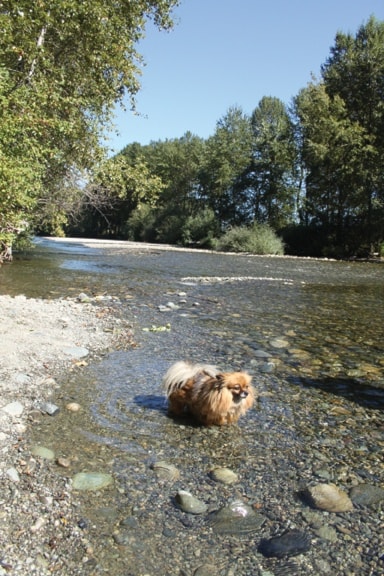If the weather continues hot and dry, as predicted, there will be zero water storage left in Cowichan Lake by Sept. 26, a situation that would be catastrophic for the Cowichan River.
This was one of the dire warnings delivered to the Cowichan Valley Regional District's regional services committee last week when Rob Hutchins and other members of the Cowichan Watershed Board presented an update on the state of river flows.
"This is a critical situation for our community that we're facing," said committee chair Gerry Giles.
For the last 11 years the region has been feeling the effects of climate change, Hutchins said, with one significant winter flood and a number of years of low flow in the summer that have required the trucking of fish up the river.
The magic number, he said, is seven cubic metres per second. This is the lowest level of flow that ensures the health of fish in the river, the dilution of sewage that's discharged from two lagoons and allows Catalyst mill in Crofton to keep running.
Predicting a bad summer, officials lowered that rate to five cubic metres per second more than a month ago, to try to hold off a water flow crisis.
Things evened out for awhile, Hutchins said, but now the river is once again in trouble.
"The fish are under stress," he said, citing a recent report that stated that as of July 13, water temperatures in some pools have risen to between 25 and 27 degrees C and that many dead fry are starting to be seen as a result.
"For us, salmon are not only a staple but an overall indicator of the health of the Valley," said Tim Kulchyski, a biologist with Cowichan Tribes.
Nevertheless, with the looming possibility of storage reaching zero, the CVRD board voted Wednesday night to support a move to lower the flows further to 4.5 cubic metres per second.
A number of diffusers that run from the JUB sewage lagoons are actually above the water level and are thus no longer working, though not all of them have to be working to ensure adequate dilution levels.
B.C. Parks is likely going to post signs on the river warning of the low water levels, Hutchins reported.
"The river flow is so low that it's actually dangerous in some areas for tubers," he explained.
"It is a message that we really have to drive home to people that we really need a long-term solution," said Lake Cowichan Mayor Ross Forrest. "It gets worse and worse every year."
To that end the Watershed Board presented several recommendations, both to address the current low water levels that are quickly becoming a crisis and how the area can avoid similar situations in the years to come.
These measures were adopted by the CVRD board Wednesday night.
There seems to be little that can be done in the short term besides conservation and hoping for significant rainfall. The group has examined the idea of putting temporary pumps in place to pump water from behind the weir at Lake Cowichan into the river.
But the cost of putting in temporary pumps for just one month is more than $1 million, Hutchins said, and there are no funds earmarked for such a project.
Even if funding could be worked out, there is also a permit process that requires a 30-day public notice period followed by a possible 45 days for a decision from provincial officials.
Director Bruce Fraser summed up the problem: "Even if you were to find the $1 million to access pumps and put them into place, the decision to actually allow you to do so may take longer than the time we actually have."
For the long term the Watershed Board recommended that the CVRD become the lead entity on the flow issue, as they have the resources and manpower to do the necessary engineering infrastructure designs to get going on the Watershed Board's recommended solutions of raising the weir by 30 centimetres and adding permanent pumps for emergencies.
The cost to raise the weir may be about $3 million, Hutchins said, and the pumps could be about $5 million, though those estimates are based on old numbers.
Stage 3 water restrictions:
FOR NOW, the CVRD areas of Bald Mountain (Woodland Shores), Dogwood Ridge, Honeymoon Bay, Mesachie Lake and Youbou, along with the Municipality of North Cowichan, the Town of Lake Cowichan and the City of Duncan have moved to stage 3 water restrictions. FOR THE CVRD areas this means watering may be carried out by hand only for one hour per designated day during either the period of 6-9 a.m. or 7-10 p.m. Residents with odd numbered houses may only water on odd numbered days and residents with even numbered houses may water only on even numbered days.
NOT ALLOWED in the CVRD areas, the Municipality of North Cowichan, the Town of Lake Cowichan and the City of Duncan: sprinkling of lawns or boulevards; filling of swimming pools, hot tubs or garden ponds; washing of vehicles, boats driveways or houses.
IN THE Municipality of North Cowichan and the City of Duncan only hand watering is allowed. People may hand water on any day between the hours of 6-9 a.m. or 7-10 p.m. IN LAKE Cowichan watering by hand can be carried out for one hour only between 6-8 a.m. or 6-8 p.m. on Tuesday, Thursday and Saturday for even numbered addresses and Wednesday, Friday and Sunday for odd numbered addresses.
